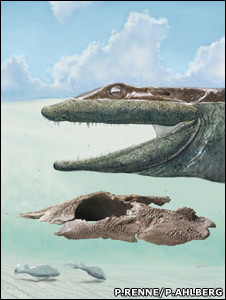
June 26, 2008

Ventastega curonica would have looked similar to a small alligator.
Scientists unearthed a skull of the most primitive four-legged creature in history, said a study in the June 26, 2008 issue of the journal Nature.
The well-preserved remains, discovered from 370-million-year-old rocks in the country of Latvia, has features of both water (fish) and land (reptilian) animals.
The fierce-looking creature probably swam through shallow brackish waters, measured about one meter long and ate other fish, scientists said in the study.
“If you saw it from a distance, it would look like a small alligator, but if you look closer you would find a fin in the back. In terms of construction, it had already undergone most of the changes from fish towards land animal, but in terms of lifestyle you are still looking at an animal that is habitually aquatic.” said Per Ahlberg, a professor of evolutionary biology at Uppsala University in Sweden.
It has long been accepted that all land animals with backbones — including humans — are descended from one small group of fish that left the water about 365 million years ago.
This suggests our understanding of the evolutionary transition from fish to tetrapod is beginning to face review.
Ahlberg points to the discovery of a fossil called Tiktaalik in Canada in 2004. It is believed to be the “missing link” in the gap between fish and land mammals.
Ventastega is a later species but is a more primitive form of transition animal.
“Ventastega fills the gap between Tiktaalik and the earliest land based mammals. All these changes in these creatures are not going in lockstep; it’s a mosaic with different parts of animal evolving at different rates. Ventastega has acquired some of land-animal characteristics, but has not yet got some of the other ones.”
For instance, the creature had primitive feet – but with a high number of digits.
“I would draw the inference that Ventastega probably had limbs very much like Acanthostega (another transitional species). These were little things sticking out of the sides, with a strangely high number of digits. You would have seven, eight, maybe even nine toes per foot, rather than five or so which you would expect to find in modern day animals,” Ahlberg said.
About Loren Coleman
Loren Coleman is one of the world’s leading cryptozoologists, some say “the” leading living cryptozoologist. Certainly, he is acknowledged as the current living American researcher and writer who has most popularized cryptozoology in the late 20th and early 21st centuries.
Starting his fieldwork and investigations in 1960, after traveling and trekking extensively in pursuit of cryptozoological mysteries, Coleman began writing to share his experiences in 1969. An honorary member of Ivan T. Sanderson’s Society for the Investigation of the Unexplained in the 1970s, Coleman has been bestowed with similar honorary memberships of the North Idaho College Cryptozoology Club in 1983, and in subsequent years, that of the British Columbia Scientific Cryptozoology Club, CryptoSafari International, and other international organizations. He was also a Life Member and Benefactor of the International Society of Cryptozoology (now-defunct).
Loren Coleman’s daily blog, as a member of the Cryptomundo Team, served as an ongoing avenue of communication for the ever-growing body of cryptozoo news from 2005 through 2013. He returned as an infrequent contributor beginning Halloween week of 2015.
Coleman is the founder in 2003, and current director of the International Cryptozoology Museum in Portland, Maine.
Filed under Breaking News, Cryptotourism, CryptoZoo News, Cryptozoology, Fossil Finds, New Species